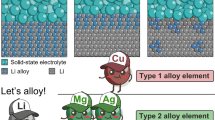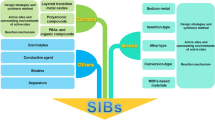Abstract
The main challenge that hinders lithium-ion batteries in space applications is their poor performance at subzero temperatures. Such poor performance is primarily due to the low ionic conductivity and freezing of the electrolyte, leading to the loss of battery capacity. This research investigates the behavior of lithium-ion batteries at low temperatures by employing electrochemical and material characterization techniques. Based on the electrochemical behavior of the battery cells, lithium-ion batteries’ performance declined rapidly at − 30 °C. The major findings indicate that charging at low-temperature conditions increases the impedance, which slows down the reaction kinetics affecting the intercalation of lithium ions. According to the results obtained from the ex situ material characterization analysis, the main factor that induces this behavior is the freezing and the decomposition of the electrolyte at the cathode-electrolyte interphase and the mechanical degradation of the active materials of the cathode. These changes lead to interfacial instability and considerable development of resistance to the flow of charges. The findings in this study contribute to the development of lithium-ion batteries for low temperature and space applications by understanding the behavior of lithium-ion batteries in subzero temperature environments.











Similar content being viewed by others
References
Schmuch R, Wagner R, Hörpel G, Placke T, Winter M (2018) Performance and cost of materials for lithium-based rechargeable automotive batteries. Nat Energy 3(4):267–278. https://doi.org/10.1038/s41560-018-0107-2
Manthiram A (2017) An outlook on lithium ion battery technology. ACS Cent Sci 3(10):1063–1069. https://doi.org/10.1021/acscentsci.7b00288
Choi JW, Aurbach D (2016) Promise and reality of post-lithium-ion batteries with high energy densities. Nat Rev Mat 1(4). https://doi.org/10.1038/natrevmats.2016.13
Nitta N, Wu F, Lee JT, Yushin G (2015) Li-ion battery materials: present and future. Mater Today 18(5):252–264. https://doi.org/10.1016/j.mattod.2014.10.040
Manthiram A (2020) A reflection on lithium-ion battery cathode chemistry. Nat Commun 11(1). https://doi.org/10.1038/s41467-020-15355-0.
Adams RA, Varma A, Pol VG (2019) Temperature dependent electrochemical performance of graphite anodes for K-ion and Li-ion batteries. J Power Sources 410–411:124–131. https://doi.org/10.1016/j.jpowsour.2018.11.007
McKissock B, Loyselle P and Vogel E (2008) Guidelines on lithium-ion battery use in space applications. NASA Center for AeroSpace Information
Hou J, Yang M, Wang D, Zhang J (2020) Fundamentals and challenges of lithium ion batteries at temperatures between −40 and 60 °C. Adv Energy Mater 10(18):1904152. https://doi.org/10.1002/aenm.201904152
Dong X, Lin Y, Li P, Ma Y, Huang J, Bin D, … Xia Y (2019) High energy rechargeable metallic lithium battery at -70°C enabled by a co-solvent electrolyte. Angewandte Chemie (International Ed. In English). https://doi.org/10.1002/anie.201900266.
Dong X, Guo Z, Guo Z, Wang Y, Xia Y (2018) Organic batteries operated at −70°C. Joule 2(5):902–913. https://doi.org/10.1016/j.joule.2018.01.017
Li Q, Jiao S, Luo L, Ding MS, Zheng J, Cartmell SS, … Xu W (2017) Wide-temperature electrolytes for lithium-ion batteries. ACS Appl Mater Interfaces 9(22):18826–18835. https://doi.org/10.1021/acsami.7b04099
Smart MC, Ratnakumar BV, Ewell RC, Surampudi S, Puglia FJ, Gitzendanner R (2018) The use of lithium-ion batteries for JPL’s Mars missions. Electrochim Acta 268:27–40. https://doi.org/10.1016/j.electacta.2018.02.0
Won JH, Lee HS, Hamenu L, Latifatu M, Lee YM, Kim KM, … Ko JM (2016) Improvement of low-temperature performance by adopting polydimethylsiloxane- g -polyacrylate and lithium-modified silica nanosalt as electrolyte additives in lithium-ion batteries. J Ind Eng Chem 37:325–329. https://doi.org/10.1016/j.jiec.2016.03.045
Walker W, Yayathi S, Shaw J, Ardebili H (2015) Thermo-electrochemical evaluation of lithium-ion batteries for space applications. J Power Sources 298:217–227. https://doi.org/10.1016/j.jpowsour.2015.08.054
Krause FC et al (2021) Performance of commercial Li-ion cells for future NASA missions and aerospace application. J Electrochem Soc. 168 040504. https://doi.org/10.1149/1945-7111/abf05f
Uno M, Ogawa K, Takeda Y, Sone Y, Tanaka K, Mita M, Saito H (2011) Development and on-orbit operation of lithium-ion pouch battery for small scientific satellite “REIMEI.” J Power Sources 196(20):8755–8763. https://doi.org/10.1016/j.jpowsour.2011.06.05
Cook R, Swan L, Plucknett K (2021) Impact of test conditions while screening lithium-ion batteries for capacity degradation in low earth orbit CubeSat space applications. Batteries 2021(7):20. https://doi.org/10.3390/batteries7010020
Huang C-K, Sakamoto JS, Wolfenstine J, Surampudi S (2000) The limits of low-temperature performance of Li-ion cells. J Electrochem Soc 147(8):2893. https://doi.org/10.1149/1.1393622
Chang W, Bommier C, Fair T, Yeung J, Patil S, Steingart D (2020) Understanding adverse effects of temperature shifts on Li-ion batteries: an operando acoustic study. J Electrochem Soc 167(9):090503. https://doi.org/10.1149/1945-7111/ab6c56
Simolka M, Heger J-F, Kaess H, Biswas I, Friedrich KA (2020) Influence of cycling profile, depth of discharge and temperature on commercial LFP/C cell aging: post-mortem material analysis of structure, morphology and chemical composition. J Appl Electrochem 50(11):1101–1117. https://doi.org/10.1007/s10800-020-01465-6
Gao Z, Zhang X, Xiao Y, Gao H, Wang H, Piao C (2019) Influence of low-temperature charge on the mechanical integrity behavior of 18650 lithium-ion battery cells subject to lateral compression. Energies 12(5):797. https://doi.org/10.3390/en12050797
Petzl M, Kasper M, Danzer MA (2015) Lithium plating in a commercial lithium-ion battery – a low-temperature aging study. J Power Sources 275:799–807. https://doi.org/10.1016/j.jpowsour.2014.11.065
Peled E, Menkin S (2017) Review—SEI: past, present and future. J Electrochem Soc 164(7):A1703–A1719. https://doi.org/10.1149/2.1441707jes
Gao Y, Rojas T, Wang K et al (2020) Low-temperature and high-rate-charging lithium metal batteries enabled by an electrochemically active monolayer-regulated interface. Nat Energy 5:534–542. https://doi.org/10.1038/s41560-020-0640-7
An SJ, Li J, Daniel C, Mohanty D, Nagpure S, Wood DL (2016) The state of understanding of the lithium-ion-battery graphite solid electrolyte interphase (SEI) and its relationship to formation cycling. Carbon 105:52–76. https://doi.org/10.1016/j.carbon.2016.04.008
Rauhala T, Jalkanen K, Romann T, Lust E, Omar N, Kallio T (2018) Low-temperature aging mechanisms of commercial graphite/LiFePO4 cells cycled with a simulated electric vehicle load profile—a post-mortem study. Journal of Energy Storage 20:344–356. https://doi.org/10.1016/j.est.2018.10.007
Gupta A, Manthiram A (2020) Designing advanced lithium‐based batteries for low‐temperature conditions. Adv Energy Mater 2001972. https://doi.org/10.1002/aenm.202001972
Zhang Z, Yang J, Huang W, Wang H, Zhou W, … Cui Y (2020) Cathode-electrolyte interphase in lithium batteries revealed by cryogenic electron microscopy. Matter. https://doi.org/10.1016/j.matt.2020.10.021
Zhang J-N, Li Q, Wang Y, Zheng J, Yu X, Li H (2018) Dynamic evolution of cathode electrolyte interphase (CEI) on high voltage LiCoO2 cathode and its interaction with Li anode. Energy Storage Materials 14:1–7. https://doi.org/10.1016/j.ensm.2018.02.016
Somo TR, Mabokela TE, Teffu DM, Sekgobela TK, Ramogayana B, Hato MJ, Modibane KD (2021) A comparative review of metal oxide surface coatings on three families of cathode materials for lithium ion batteries. Coatings 11(7):744. https://doi.org/10.3390/coatings11070744
Barbosa JC, Gonçalves R, Costa CM, Lanceros-Mendez S (2021) Recent advances on materials for lithium-ion batteries. Energies 14(11):3145. https://doi.org/10.3390/en14113145
He L, Li K, Zhang Y, Liu J (2020) Structural and electrochemical properties of low- cobalt-content LiNi0.6+xCo0.2–xMn0.2O2 (0.0 ≤ x ≤ 0.1) cathodes for lithium-ion batteries. ACS Appl. Mater. Interfaces 12 (25):28253. https://doi.org/10.1021/acsami.0c06824
Li F, Liu Z, Shen J, Xu X, Zeng L, … Zhu M (2021) A nanorod-like Ni-rich layered cathode with enhanced Li+ diffusion pathways for high-performance lithium-ion batteries. J Mater Chem A 9(5):2830–2839. https://doi.org/10.1039/d0ta10608a
Li F, Liu Z, Shen J, Xu X, Zeng L, Li Y, … Liu J (2020) Ni-rich layered oxide with preferred orientation (110) plane as a stable cathode material for high-energy lithium-ion batteries. Nanomaterials, 10(12), 2495. https://doi.org/10.3390/nano10122495
He L, Li K, Zhang Y, Liu J (2021) Substantial doping engineering in layered LiNi0.5+xCo0.2−xMn0.3O2 materials for lithium-ion batteries. J Electrochem Soc 168(6):060534. doi.https://doi.org/10.1149/1945-7111/ac0aa7.
Mun J, Ha H-W, Choi W (2014) Nano LiFePO4 in reduced graphene oxide framework for efficient high-rate lithium storage. J Power Sources 251:386–392. https://doi.org/10.1016/j.jpowsour.2013.11.03
Friesen A, Hildebrand S, Horsthemke F, Börner M, Klöpsch R, Niehoff P, … Winter M (2017) Al 2 O 3 coating on anode surface in lithium ion batteries: impact on low temperature cycling and safety behavior. J Power Sources, 363:70–77. https://doi.org/10.1016/j.jpowsour.2017.07.06
Tron A, Jeong S, Park YD, Mun J (2019) Aqueous lithium ion battery of nano-LiFePO4 with anti-freezing agent of ethyleneglycol for low temperature operation. ACS Sustain Chem Eng. https://doi.org/10.1021/acssuschemeng.9b02042
Kang F, Ma J, Li B (2011) Effects of carbonaceous materials on the physical and electrochemical performance of a LiFePO4 cathode for lithium-ion batteries. Carbon 49(13):4608. https://doi.org/10.1016/j.carbon.2011.06.017
Julien CM, Zhang X, Mauger A (2017) Lithium iron phosphate: olivine material for high power Li-ion batteries. Res Dev Mater Sci 2. https://doi.org/10.31031/RDMS.2017.02.000545
Bhabu Kanagaraj A, Chaturvedi P, Jin Kim H, Choi DS (2020) Controllable synthesis of LiFePO4 microrods and its superior electrochemical performance. Mater Lett 128737. https://doi.org/10.1016/j.matlet.2020.128737
Xiuqin O, Lin P, Haichen G, Yichen W, Jianwei L (2012) Temperature-dependent crystallinity and morphology of LiFePO4 prepared by hydrothermal synthesis. J Mater Chem 22(18):9064. https://doi.org/10.1039/c2jm30191a
Zheng H, Li J, Song X, Liu G, Battaglia VS (2012) A comprehensive understanding of electrode thickness effects on the electrochemical performances of Li-ion battery cathodes. Electrochim Acta 71:258–265. https://doi.org/10.1016/j.electacta.2012.03.161
Shutthanandan V, Nandasiri M, Zheng J, Engelhard MH, Xu W, Thevuthasan S, Murugesan V (2018) Applications of XPS in the characterization of battery materials. J Electron Spectrosc Relat Phenom. https://doi.org/10.1016/j.elspec.2018.05.005
Lee H, Lim H.-S, Ren X, Yu L, … Zhang J.-G (2018) Detrimental effects of chemical crossover from lithium anode to cathode in rechargeable lithium metal batteries. ACS Energy Letters. https://doi.org/10.1021/acsenergylett.8b01819.
Rho Y-H, Nazar LF, Perry L, Ryan D (2007) Surface chemistry of LiFePO4 studied by Mössbauer and X-ray photoelectron spectroscopy and its effect on electrochemical properties. J Electrochem Soc 154(4):A283. https://doi.org/10.1149/1.2433539
Funding
Financial support provided by the United Arab Emirates Space Agency, Space Missions’ Science and Technology Directorate, Reference M04-2016–001, and Korea-UAE Joint R&D Technical Center (KUTC), under Award No. 8474000259.
Author information
Authors and Affiliations
Corresponding author
Ethics declarations
Conflict of interest
The authors declare no competing interests.
Additional information
Publisher's note
Springer Nature remains neutral with regard to jurisdictional claims in published maps and institutional affiliations.
Rights and permissions
Springer Nature or its licensor (e.g. a society or other partner) holds exclusive rights to this article under a publishing agreement with the author(s) or other rightsholder(s); author self-archiving of the accepted manuscript version of this article is solely governed by the terms of such publishing agreement and applicable law.
About this article
Cite this article
Alhammadi, A.S., Yun, H.J. & Choi, D. Investigation of LiFePO4/MWCNT cathode-based half-cell lithium-ion batteries in subzero temperature environments. Ionics 29, 2163–2174 (2023). https://doi.org/10.1007/s11581-023-04953-9
Received:
Revised:
Accepted:
Published:
Issue Date:
DOI: https://doi.org/10.1007/s11581-023-04953-9




